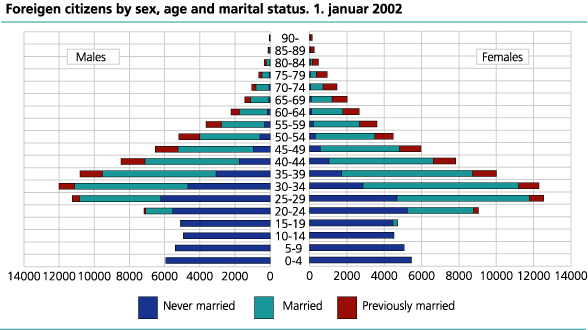Content
Published:
This is an archived release.
Lower growth in number of foreign citizens
From 1998 and onwards there has been a steady growth in the number of foreign citizens in Norway, however, in 2001 the number of foreign citizens only increased by 1 500 persons. By 1 January 2001 nearly 185 900 foreign citizens resided in Norway, equivalent to 4.1 per cent of the population. The somewhat slower growth is mainly due to lower immigration and an increased number of naturalizations.
Swedish and Danish citizens comprise the largest groups of foreign citizens in Norway. On 1 January 2002 approximately 25 200 Swedish and 19 700 Danish persons were resident in Norway. These numbers have been stable after the turn of the century. Persons with British (11 000), Iraqi (10 800) and Bosnian (8 800) citizenship follow thereafter. Roughly 62 per cent of the foreign citizens are Europeans.
The number of foreign citizens with background from the former Yugoslavia has decreased rapidly during the last years. This is mainly due to naturalizations, not remigration. During 2001 several Bosnians had fulfilled the demand for 7 years of residency, hence 300 persons with Bosnian background were naturalized. In addition approximately 1200 Yugoslavians were granted citizenship in 2001.
The largest relative increase among the foreign citizens has been among persons with Afghan background, the number nearly doubled, to 1 800 persons in 2001. The increase from last year in the number of persons with Iraqi background continued and during 2001 the group increased by 900 persons, the largest growth of all groups measured in crude numbers.
Few old people among the foreign citizens
Roughly 46 per cent of the foreign citizens are between 20 and 39 years old. Only 4 per cent are 67 years or older. In the rest of the population 28 per cent are between 20 and 39 years old and only 13 per cent are 67 years of age or older. In total numbers the differences between the sexes are pivotal. However there are huge differences when we consider country background. Among the citizens from Iraq (67 per cent) and Afghanistan (56 per cent) there is a surplus of men. The opposite is true for those with background from Thailand and Russia where the share of women is respectively 86 and 72 per cent.
Highest share in Båtsfjord
Of the municipalities Båtsfjord has the highest share of foreign citizens numbering 14.1 per cent, followed by Oslo (9.5 per cent) and Fjaler (9.3 per cent). Among the ten municipalities with the highest share of foreign citizens there are four municipalities situated in Finnmark. This must be seen in association with high immigration from Russia and Finland. In crude numbers Oslo tops the charts with 48 600 foreign citizens, followed by Bergen (9 900) and Stavanger (6 800). More than half of the foreign citizens are situated in the ten largest municipalities, 50 of the municipalities in Norway have less than 25 foreign citizens.
Lowest in Scandinavia
Compared with the other Scandinavian countries Sweden has the highest share of foreign citizens with 5.4 per cent, Denmark has 4.8 per cent and Norway the lowest with 4.1 per cent. However, these numbers do not reveal the true number of persons resident with background from immigration. Between 1977 and 2001 approximately 138 300 persons have been naturalized in Norway alone. In other words the numbers describing the immigrant population is clearly different from the number of foreign citizens.
Tables:
- Table 1 Foreign citizens. Number and as a percentage of population. County. 1 January 1976-2002
- Table 2 Foreign citizens, by citizenship per 1 January 1975-2002
- Table 3 Foreigen citizen, by sex, age and citizenship. 1 January 2002
- Table 4 Foreigen citizens, by sex, marital status and citizenship. 1 January 2002
- Table 5 Foreigen citizens, by marital status, sex and age. 1 January 2002
- Table 6 Foreigen citizens, by sex, marital status, age and county. 1 January 2002
- Table 7 Foreigen citizens, by citizenship and county. 1 January 2002
- Table 8 Foreigen citizens, by citizenship. Selected municipalities. 1 January 2002
- Table 9 Foreign citizens by citizenship. Municipality. 1 January 2002
- Table 9.1 Østfold
- Table 9.2 Akershus and Oslo
- Table 9.3 Hedmark
- Table 9.4 Oppland
- Table 9.5 Buskerud
- Table 9.6 Vestfold
- Table 9.7 Telemark
- Table 9.8 Aust-Agder
- Table 9.9 Vest-Agder
- Table 9.10 Rogaland
- Table 9.11 Hordaland
- Table 9.12 Sogn og Fjordane
- Table 9.13 Møre og Romsdal
- Table 9.14 Sør-Trøndelag
- Table 9.15 Nord-Trøndelag
- Table 9.16 Nordland
- Table 9.17 Troms
- Table 9.18 Finnmark
The statistics is published with Population.
Contact
-
Statistics Norway's Information Centre
E-mail: informasjon@ssb.no
tel.: (+47) 21 09 46 42

